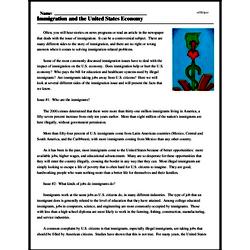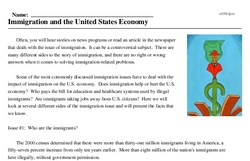Immigration and the United States Economy
Often, you will hear stories on news programs or read an article in the newspaper that deals with the issue of immigration. It can be a controversial subject. There are many different sides to the story of immigration, and there are no right or wrong answers when it comes to solving immigration-related problems.
Some of the most commonly discussed immigration issues have to deal with the impact of immigration on the U.S. economy. Does immigration help or hurt the U.S. economy? Who pays the bill for education and healthcare systems used by illegal immigrants? Are immigrants taking jobs away from U.S. citizens? Here we will look at several different sides of the immigration issue and will present the facts that we know.
Issue #1: Who are the immigrants?
The 2000 census determined that there were more than thirty-one million immigrants living in America, a fifty-seven percent increase from only ten years earlier. More than eight million of the nation's immigrants are here illegally, without government permission.
More than fifty-four percent of U.S. immigrants come from Latin American countries (Mexico, Central and South America, and the Caribbean), with more immigrants coming from Mexico than any other country.
As it has been in the past, most immigrants come to the United States because of better opportunities: more available jobs, higher wages, and educational advancement. Many are so desperate for these opportunities that they will enter the country illegally, crossing the border in any way that they can. Most illegal immigrants are simply looking to escape a life of poverty that is often hard for U.S. citizens to imagine. They are good, hardworking people who want nothing more than a better life for themselves and their families.
Issue #2: What kinds of jobs do immigrants do?
Immigrants work at the same jobs as U.S. citizens do, in many different industries. The type of job that an immigrant does is generally related to the level of education that they have attained. Among college educated immigrants, jobs in computers, science, and engineering are most commonly occupied by immigrants. Those with less than a high school diploma are most likely to work in the farming, fishing, construction, manufacturing, and service industries.




